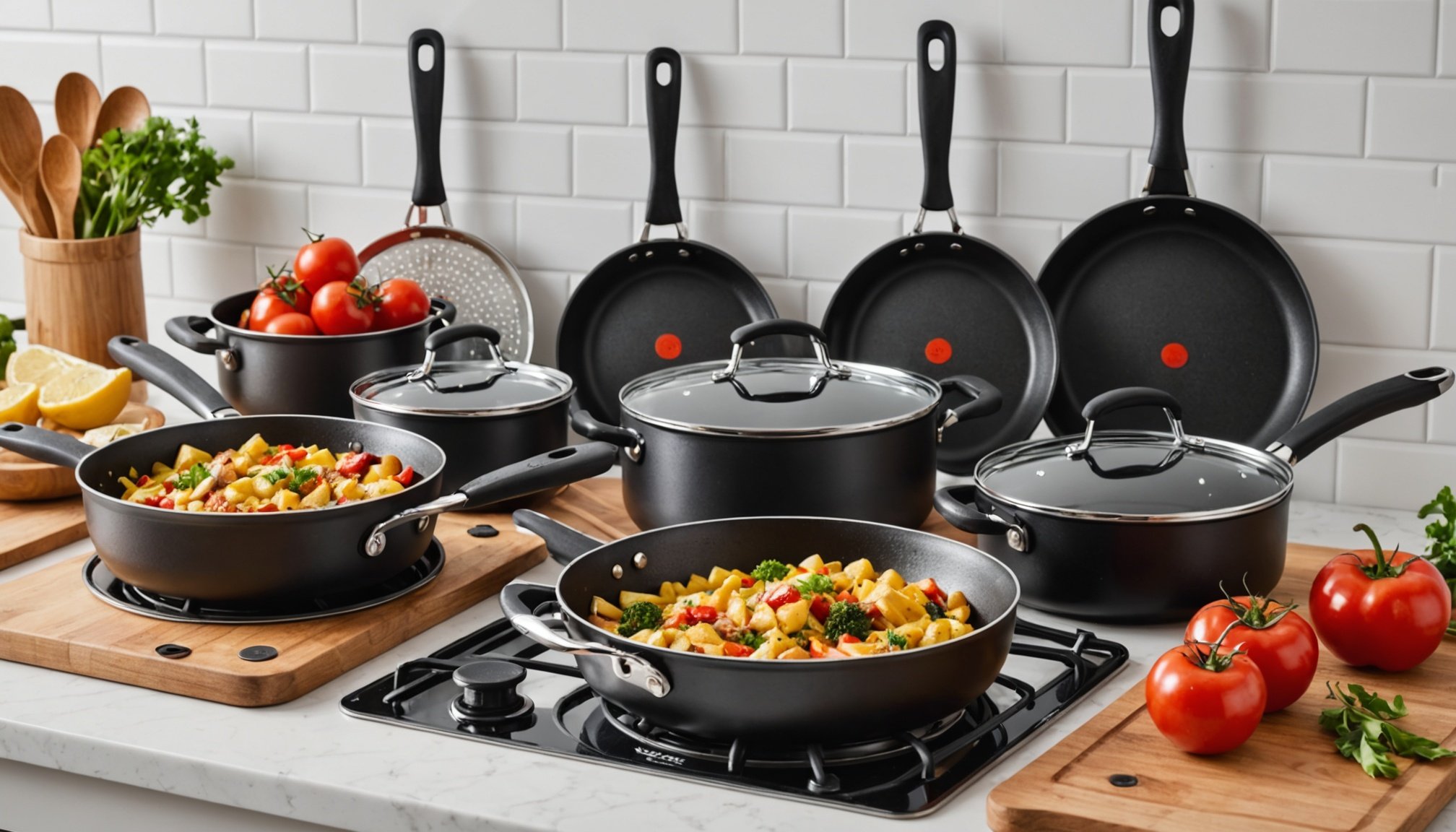Overview of Non-Stick Cookware
Non-stick cookware has become a staple in modern kitchens, praised for its versatility and convenience. Typically, these innovative cooking tools feature surfaces that prevent food from sticking, making both cooking and cleaning easier.
Definition and Types
Non-stick cookware includes a range of items such as frying pans, saucepans, and bakeware, all designed to minimize food adhesion. The types available often vary by coating material and construction, offering different benefits based on user needs.
This might interest you : Revamp Your Diet: How Clear Fridge Doors Encourage Healthier Eating at Home
Common Materials
The non-stick surfaces are traditionally coated with materials like Teflon or other PTFE-based compounds, allowing for smooth cooking experiences. More recent options include ceramic coatings, which are touted as environmentally friendly and free from chemicals like PFOA and PFOS.
Advantages
The primary advantage of non-stick cookware lies in its ability to facilitate low-fat cooking. By minimizing the need for oils and butter, these tools support a healthier lifestyle. Additionally, they promote even cooking and reduce the risk of burnt offerings, making them ideal for both novice and experienced cooks. Thus, incorporating non-stick cookware in everyday cooking not only improves meal preparation but also contributes to better dietary habits.
Also to read : Revitalize your weight loss journey: discover the advantages of using a meal planning whiteboard in your kitchen
Health Benefits of Using Non-Stick Cookware
Non-stick cookware has made waves in the culinary world, particularly for its ability to reduce fat in cooking. One of its primary appeals is the reduction of oil and butter, which aligns with healthier eating and modern dietary preferences. With these surfaces, users can significantly lower the amount of fat in their dishes without sacrificing flavour. This reduction in fats can have a substantive impact on overall nutrition by encouraging healthier cooking methods.
By default, non-stick cookware supports a healthier diet, as scientific studies highlight its contribution to improved eating habits. The key aspect here is the non-reliance on oils, which translates to fewer calories and less saturated fat in meals. Research indicates that consistent use of non-stick cookware can assist in weight management and offer cardiovascular benefits—an advantage not as easily achieved with traditional cookware.
Furthermore, for those achieving results through healthier eating, the transition to non-stick surfaces can be a seamless integration into sustainable dietary practices. By aligning cooking methods with health-conscious choices, non-stick cookware proves to be not just a convenience but a pivotal part of a health-focused kitchen.
Tips for Cooking with Non-Stick Cookware
When using non-stick cookware, adopting the right cooking techniques is crucial to maximize its benefits. A key tip is to preheat your pan on low to medium heat. Overheating can degrade the coating and shorten its lifespan. Use recommended temperatures and avoid high heat to preserve the non-stick quality, ensuring even cooking and preventing unnecessary wear.
Choosing appropriate utensils is just as important. Opt for wooden, silicone, or plastic tools that won’t scratch the surface. Metal utensils can damage the coating, impacting the cookware’s efficiency and longevity. These compatible tools help maintain the integrity of the non-stick layers, ensuring they remain effective across numerous uses.
For optimal results, apply a small amount of oil or butter even on non-stick surfaces. While these pans allow for reduced fat use, incorporating minimal amounts can enhance flavour and prevent food from drying out—particularly when cooking proteins.
Finally, practice gentle cooking techniques. Stirring or flipping food with care can prolong the life of your cookware, maintaining its non-stick properties and delivering consistently positive cooking experiences. This thoughtful approach also reduces the risk of accidental spills or kitchen mishaps.
Comparison with Traditional Cookware
When evaluating non-stick vs traditional cookware, a noticeable difference emerges in fat and calorie content. Non-stick cookware requires less oil and butter, hence reducing the overall calorie count of meals. This offers a distinct health advantage, particularly for individuals focused on healthy eating habits.
In terms of cooking efficiency, non-stick options often provide more convenience. Cooking times can be shortened as the even heat distribution of non-stick surfaces facilitates quicker meal preparation compared to traditional pots and pans. This time-saving aspect is invaluable for busy individuals seeking efficient cooking methods.
However, the health impact also extends to the potential risks. Traditional cookware materials can sometimes release unwanted substances into food, a point non-stick varieties have addressed through safer coatings. Yet, long-term maintenance is key; non-stick surfaces require careful handling to preserve their properties. Misuse, such as overheating or using improper utensils, can lead to degraded performance over time.
In conclusion, while non-stick cookware supports faster, healthier meal creation, proper care ensures longevity and optimal benefits. Awareness of these differences helps users make informed decisions that align with their culinary and dietary priorities.
Maintaining Non-Stick Cookware
Proper preservation of non-stick cookware is crucial for extending its lifespan and maintaining its effectiveness. One key practice is to avoid using abrasive cleaning tools or harsh detergents, which can damage the non-stick coating. Instead, opt for soft sponges and mild dish soap to gently cleanse the surface after cooking.
Another common error to avoid is stacking non-stick items without protection. Consider using paper towels or soft liners between pans to prevent scratches. Over time, these seemingly small actions contribute to the longevity of your cookware.
Regularly inspecting your cookware is also advisable. Look for signs of wear, including chipping or peeling of the coating. If you notice these, it might be time to consider replacing the items. Performing these checks helps maintain the cookware’s integrity and effectiveness.
Furthermore, always allow non-stick cookware to cool before cleaning. Exposing a hot pan to cold water can warp the material and impair its non-stick properties. Adhering to these maintenance tips not only prolongs the life of your non-stick cookware but also ensures continued satisfactory cooking results.
Recipes Demonstrating Fat Reduction
Using non-stick cookware can revolutionize your approach to low-fat cooking, transforming ordinary recipes into healthier feats. Non-stick recipe adaptations are a great start. Consider sautéing vegetables with just a splash of olive oil; the non-stick surface reduces the need for copious amounts, yet ensures even cooking and retained flavours. For a breakfast twist, try scrambled eggs with a minimal pat of butter. The non-stick skillet not only makes the process smoother but also contributes to lighter, fluffier eggs without excess grease.
Classic recipes like stir-fries can be given a healthy makeover using these tools. Opt for lean proteins, diced vegetables, and a touch of soy sauce or low-fat alternatives. The need for oil is naturally reduced, enabling a guilt-free, nutritious meal.
For those looking to experiment, users often submit recipes highlighting innovative uses of non-stick cookware. These user-submitted ideas range from savoury dishes to light desserts, all emphasizing fat reduction without compromising taste.
These recipes not only display the versatility of non-stick cookware but also align with health-focused culinary goals, offering a practical and enjoyable way to maintain balanced meals.
User Reviews and Recommendations
Exploring user reviews offers valuable insight into the perceived effectiveness of non-stick cookware in promoting healthier cooking. Popular brands frequently lauded include Tefal and GreenPan, known for their durable coatings and ease of use. These brands are often recommended for their ability to facilitate low-fat cooking, aligning with modern dietary goals.
Users highlight the quality and longevity of products that allow cooking with minimal or no added fats. The easy-to-clean surfaces significantly appeal to busy individuals, complementing efficient meal preparation with minimal effort. Feedback often emphasizes non-stick durability, a vital factor when cooking at various temperatures.
Key features appreciated by users include even heat distribution, resistance to scratches, and user-friendly designs. Some reviews focus on specific cookware items like fry pans and baking sheets, noting their significant impact on reducing fat in everyday recipes. Others mention the ergonomic benefits of handles and weight balance, which contribute to overall cooking ease.
Enthusiasts of non-stick options frequently encourage beginners to invest in these pieces, citing their potential for improving cooking outcomes and fostering healthier dietary practices. Such recommendations affirm the practical benefits experienced across diverse culinary applications.











